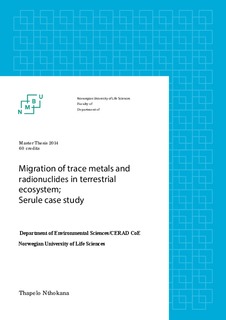| dc.description.abstract | Total trace metals concentrations were obtained using established methods based on inductively coupled plasma-mass spectroscopy at the Department of Plant Science of the University of Life Sciences, Ås, Norway. All the metals prove to have concentration levels below the maximum permissible soil load, for example, for Pb and Cr the highest concentration of (19.20 ± 5.20) mg/kg and (71.80 ± 10.52) mg/kg respectively, were well below permissible limit of 200 mg/kg. The maximum concentrations of Cu and Cd were (30.80 ± 7.43) mg/kg and (0.45 ±0.017) mg/kg respectively, were lower than the permissible limit of 100 mg/kg in soils. Soil concentration of trace metals was always higher than that in plants growing on the soil meaning that C. mopane does not accumulate the metals. Hence all soil to plant metal transfers factors were below unity. The transfer factors were of the order Zn > Cd >Cu >Mn > Ni >As > Cr > Co > U > Pb > Fe > Th. Most of the transfer factors varied with soil Mn, Fe and pH characterised by very high correlation coefficients. Thus, implying that the uptake of trace metals by plants via root uptake depends on the soil properties.
In contrast to transfer factor, the concentration factor was higher than unity for all trace metals as Imbrasia belina caterpillars tended to accumulate trace metals more than leaves of Colospermum mopane. Zn appeared to have the highest concentration factor, probably due to its essential physiological function in animals. Next is As although As has no known physiological function. Then follows Cr, Fe and Mn, and finally a number of trace metals which also lack beneficial function to organisms; U, Th and Pb. All these metals have standard deviations at least equivalent to 50% of their mean values, which means they are not inhomogeneously distributed in the samples. Cu is more homogeneous as it probably due to I. belina’s effort to regulate Cu concentration because Cu is an oxygen transport vehicle in arthropods.
The most potent radio-toxin from uranium mining is alpha emitting 210Po. At 138 day half-life and alpha particles characterised by 5.34 MeV of energy, 210Po represents a risk to animals especially when incorporated in the organisms. To assess this risk, 210Po was quantified in soil, plant and larvae by alpha spectrometry analysis at Isotope Laboratories, NMBU.
Significant difference was found in soil 210Po activity concentration between the samples collected from proposed mining site and reference site except for sample 1and 3. Sample 1 had activity concentration lower that reference site while sample 3 had a range that overlapped with the range of the reference sample. The rest of the sample were well above the reference level implying that the proposed mining site had more polonium that the reference site. The variations of 210Po mirrored that of U in soil in support of the expectation that below 0.2 m below the soil surface, all 210Po is due to decay of U which consists primarily 238U.
210Po activity concentration in C. mopane was at its highest in sample 5 at 1250 ± 65 Bq/kg which also had the highest U concentration and there was little variation for the rest of the samples with a range, 47 ± 4 to 66 ± 6 Bq/kg. Based on the close activity concentration range of 210Po at the proposed mining site, a significant difference between 210Po concentration at the proposed mining and the reference sites was obtained. Furthermore, the linearity between 210Po and U was reduced, thus reflecting that at low soil concentrations, the root intake was of minor importance for the 210Po accumulation by plants compared to atmospheric deposition. However, sample 5, with its 210Po concentration at least twice that measured in the remaining samples indicated that at high soil concentrations, root uptake plays a significant role in ecological transfer of 210Po. | nb_NO |
